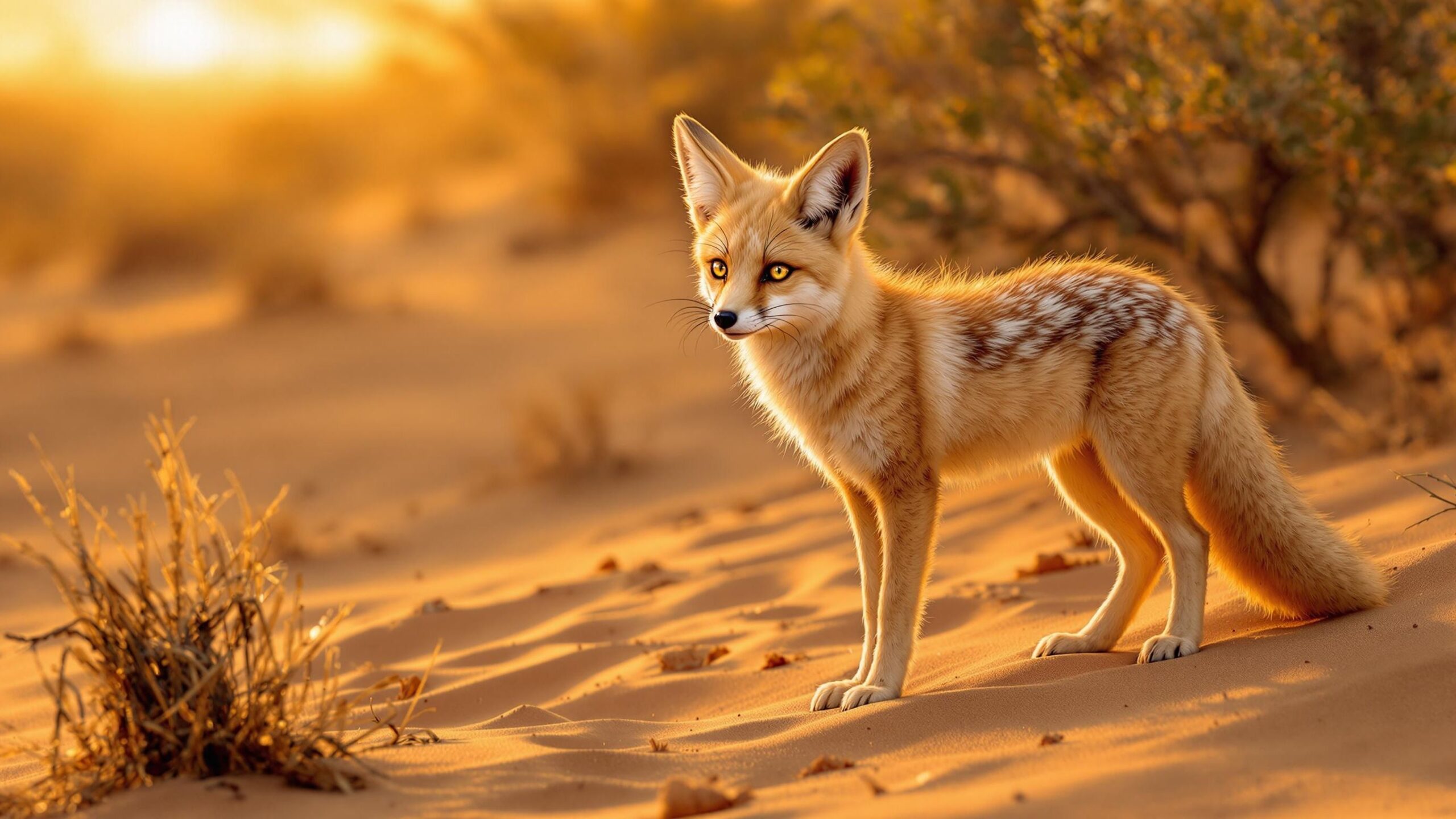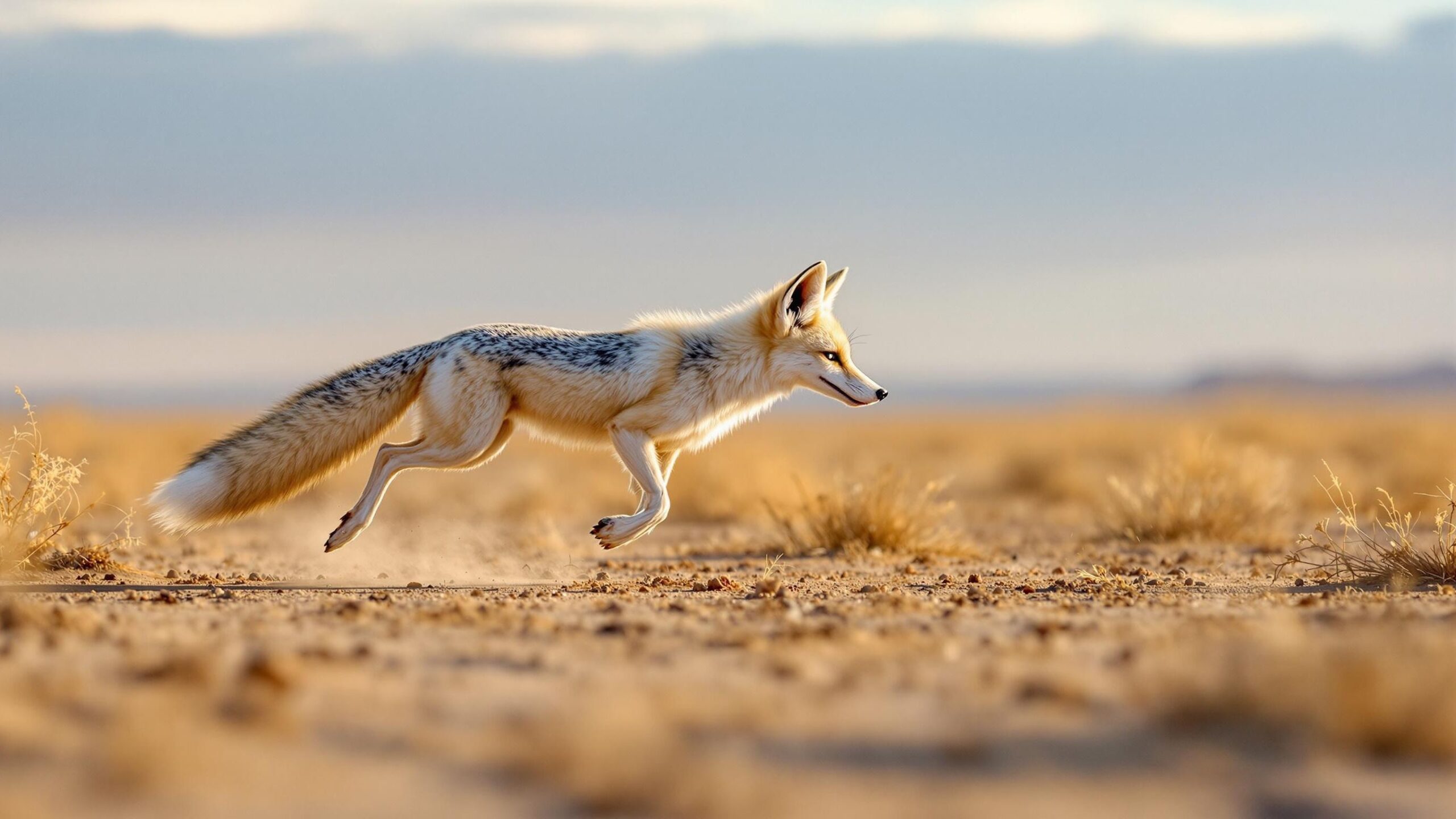The Pale Fox: A Subtle Survivor of the Sahel
In the shimmering heat of the African Sahel, where vast dry plains stretch between the Sahara Desert and the savannas to the south, lives one of the most elusive and understated fox species in the world—the Pale Fox. Known scientifically as Vulpes pallida, this elegant creature is as mysterious as the region it inhabits. With its dusty coat, slender frame, and stealthy habits, the Pale Fox epitomizes survival through subtlety. Although rarely seen and little studied, this fox plays an important role in its fragile ecosystem, quietly thriving in some of the continent’s most challenging environments.
A Fox Among the Dunes
The Pale Fox makes its home in the Sahel—a semi-arid transition zone that spans across several countries, including Mauritania, Mali, Niger, Chad, and Sudan. This is a land of contrasts, caught between the arid Sahara to the north and the lush savannas of central Africa to the south. Rainfall is sparse and seasonal, vegetation is low and scattered, and the temperature extremes can be brutal. It’s an environment where only the hardiest of animals survive. In this dry, open expanse, the Pale Fox has carved out a unique ecological niche. It prefers scrublands, arid plains, and sandy soils, where it can easily dig its extensive burrow systems. Despite its wide distribution, it remains one of the least studied wild canids in Africa, largely due to its nocturnal nature and remote habitat. Yet wherever it roams, it leaves behind subtle traces—paw prints in the dust, tufts of fur in the brush, and the occasional glimpse of a pale silhouette under moonlight.
An Elegant Design
The Pale Fox is a visual study in adaptation. Slender and graceful, it typically weighs between 4 and 7 pounds and measures up to 18 inches in body length, with an additional 10 to 14 inches for its bushy tail. Its legs are long and thin, built for covering ground with minimal effort. The tail is tipped with black and often carried low, trailing behind like a painter’s brush.
The fur is, as its name implies, pale—generally a sandy beige or light gray, perfectly matched to the dusty Sahelian environment. This coloration helps the fox remain camouflaged during twilight and night, while also reflecting harsh daytime sunlight when it emerges from its burrow. Its underbelly is usually lighter in tone, and faint dark markings may trace its muzzle and back. One of the fox’s most striking features is its ears. Large and upright, they serve two important functions: dissipating heat and detecting sound. In the quiet of the desert night, those ears can pick up the faintest rustle of prey moving beneath the surface or the distant call of another fox. Its eyes, golden and alert, are suited for nocturnal activity, reflecting light like mirrors when caught in a beam.
Living by the Night
Pale Foxes are strictly nocturnal, avoiding the blistering heat of the day by sheltering deep within their underground dens. These dens are impressive constructions, often featuring multiple entrances, long tunnels, and cool chambers that provide a refuge from the intense sun. Families may share a burrow, with separate tunnels for pups and adults. During the day, the fox rests, conserving energy for its nightly forays across the open plains.
Once the sun sets, the Pale Fox becomes active, emerging cautiously from its den to hunt and forage. Its movements are quiet and efficient, gliding almost ghost-like across the ground in search of food. It covers large distances each night, using its keen senses to locate prey and avoid potential dangers. While primarily solitary when foraging, the Pale Fox may live in small family groups, especially during the breeding season or while raising pups. It communicates through a range of vocalizations—barks, yips, and whines—though it’s generally a quiet animal. Scent marking is also used to establish territory and communicate with other foxes.
A Varied and Opportunistic Diet
The Pale Fox is an omnivore with a highly flexible diet, a crucial trait for survival in the resource-scarce Sahel. It feeds on a variety of small animals, including rodents, insects, reptiles, and birds. When live prey is scarce, it scavenges or turns to plant matter. Fruits, roots, berries, and seeds all feature in its diet, especially during the brief rainy season when plant life flourishes.
One of the Pale Fox’s most fascinating adaptations is its ability to survive with minimal access to free water. Like many desert-dwelling animals, it extracts moisture from its food, particularly fruits and insects, and conserves water through efficient metabolic processes. This makes it incredibly well-suited to the Sahel, where permanent water sources are few and far between. Its feeding habits also play a role in maintaining ecological balance. By preying on rodents and insects, the Pale Fox helps control populations that might otherwise damage crops or spread disease. In this way, the fox is not just a survivor, but a silent steward of its environment.

Courtship, Mating, and Family Life
The Pale Fox is believed to be monogamous, forming lifelong pairs that remain together through multiple breeding seasons. The mating season is not rigidly fixed but generally occurs during the dry season, when conditions are stable and dens are dry enough to safely raise pups. After a gestation period of approximately 50 to 60 days, the female gives birth to a litter of 3 to 6 pups, although larger litters have occasionally been reported. The pups are born blind and helpless, sheltered deep within the den and nursed by the mother while the father forages for food. Both parents are involved in raising the young, and the family remains together for several months as the pups learn essential survival skills. By the time they are weaned, usually around eight weeks of age, the pups begin venturing outside the den under supervision. They practice pouncing, stalking, and digging—behaviors that will later determine their ability to survive independently. By early adolescence, the young foxes disperse to establish territories of their own.
Subtle in the Wild, Absent in the City
Unlike some other fox species, such as the adaptable Red Fox or urban-savvy Fennec Fox, the Pale Fox is rarely found near human settlements. It shows a strong preference for wild, open landscapes, avoiding villages, farms, and roads when possible. This makes it less likely to come into conflict with humans, but also means it is more vulnerable to habitat loss and environmental degradation.
Despite its elusive nature, local communities are often aware of the Pale Fox, recognizing it as a nocturnal visitor to their lands. In some regions, traditional beliefs associate the fox with cleverness or mystery. However, it is seldom hunted or persecuted, and its inconspicuous lifestyle helps it avoid negative attention. In agricultural zones where land use is expanding, the Pale Fox may face pressures from overgrazing, land clearing, and pesticide use. These practices can reduce the availability of prey or disrupt burrow sites, indirectly impacting the fox’s survival. Nevertheless, the species has proven resilient, adjusting its range as needed to follow food and shelter.
Conservation: Out of Sight, But Not Forgotten
The Pale Fox is currently listed as a species of “Least Concern” by the International Union for Conservation of Nature (IUCN). This classification reflects its broad geographic range and presumed large population. However, researchers caution that this status should not lead to complacency. Because the Pale Fox is so rarely observed and poorly studied, there are large gaps in our knowledge about its true numbers, behavior, and ecological role. In recent years, growing interest in Sahelian wildlife has prompted more research efforts, including camera trapping and observational studies in protected areas. These initiatives aim to better understand not only the Pale Fox but the health of the entire ecosystem it inhabits. Conservationists advocate for protecting key habitats, promoting sustainable grazing practices, and increasing awareness of the region’s lesser-known species. The Pale Fox may not be endangered, but it represents a delicate balance that could shift rapidly in a changing climate.
A Fox Shaped by the Sun and Sand
The Pale Fox is the product of millennia of evolution in one of Africa’s most challenging environments. Everything about its form and function is shaped by the Sahel—its soft, light-colored coat, its oversized ears, its dietary flexibility, and its nocturnal nature. Unlike its flashier relatives, the Pale Fox does not seek attention or spectacle. It simply exists, quietly and effectively, where others cannot. Its movements are graceful, its voice is hushed, and its role is vital. It stands as a reminder that not all survival stories are loud. Some unfold in the dark, among the dunes, in the footsteps of an animal that leaves barely a trace.

Why the Pale Fox Matters
In the grand tapestry of African wildlife, the Pale Fox is a subtle thread, easily overlooked but tightly woven into the fabric of the ecosystem. As a predator, scavenger, and forager, it contributes to the regulation of species populations and the dispersal of seeds. Its survival is a barometer of ecological balance in a region increasingly under stress from desertification, climate change, and human expansion. Understanding and appreciating the Pale Fox is not just about preserving a single species—it’s about recognizing the complexity of the ecosystems we so often oversimplify. The fox’s quiet success in the Sahel offers a powerful example of resilience through adaptation, of life flourishing where conditions seem least favorable.
The Future of a Ghostly Guardian
The future of the Pale Fox depends on a mix of natural resilience and human responsibility. While it currently faces no major direct threats, indirect pressures continue to mount. Expanding agriculture, unsustainable grazing, and climate shifts all pose risks, even if those risks remain poorly quantified. Researchers and conservationists are working to change that, advocating for more comprehensive surveys and conservation measures that include not only large charismatic animals but also quiet contributors like the Pale Fox. Public interest is also growing, thanks in part to a renewed focus on biodiversity in arid zones and the increasing accessibility of camera trap imagery and digital wildlife resources. With continued study and thoughtful management, there is every reason to believe the Pale Fox will remain a presence in the Sahel for generations to come—a soft-footed, sharp-eared sentinel of Africa’s great dry heart.
The Quiet Wonder of the Sahel
The Pale Fox, Vulpes pallida, may not roar, howl, or dazzle, but it doesn’t need to. It thrives in one of the most demanding landscapes on Earth through stealth, adaptability, and efficiency. It is a fox of the night, a creature of balance, and a quiet wonder of the African wilderness. For those lucky enough to spot its pale form slipping across the dunes or catch its eyes reflecting starlight from a hidden burrow, the Pale Fox is unforgettable. And for the Sahel, it is indispensable—an elegant emissary of an ecosystem that is as delicate as it is enduring.

